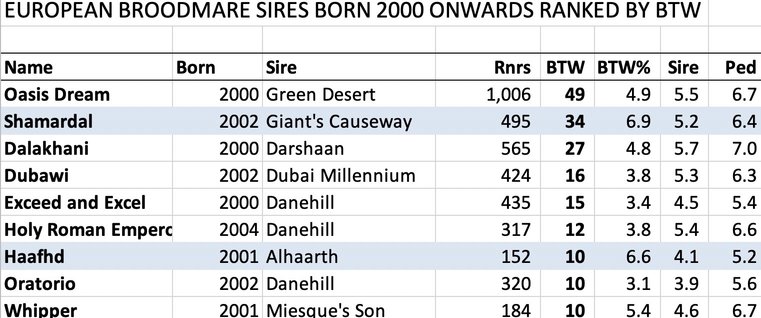Good sire, good broodmare sire. That, understandably, has been the story of many stallions down through history. But it doesn’t always work out that way. So what really is a good broodmare sire? How can we prove the added value brought by the broodmare sire? There has always been a suspicion that if a stallion gets access to good quality mares during his stallion career, it’s very likely that these mares will play a big part in building a good reputation as a broodmare sire.
There are, of course, further benefits to be had when the mares by one stallion are particularly compatible with the major sire of the day. There’s no doubt, for instance, that Danehill mares were extremely fortunate to have Galileo around. And we can argue that Galileo’s daughters have not been blessed with the same opportunities. It was the same for Darshaan, who struck up a fruitful relationship with Sadler’s Wells. That said, it’s extremely rare to build a worthwhile reputation with just one stallion, however dominant he may be.
Darshaan is a good case study in that his daughters produced some of the best by Sadler’s Wells, but he had other strings to his bow, too. His 225 stakes winners as a broodmare sire accounted for 9.1% of his northern hemisphere runners and 28 were by Sadler’s Wells and 95 were by Sadler’s Wells or his male-line descendants. A 9.1% stakes winner-to-runner strike-rate is excellent for a broodmare sire and is rarely achieved. In fact, Darshaan’s performance is put in perspective when we count up the various strike-rates of all the stallions that covered his mares. That numbers stands at 6.8%, so we can immediately understand that Darshaan plays a dominant role.
“It’s extremely rare to build a worthwhile reputation with just one stallion, however dominant he may be”
Moreover, when we check the pedigree quality of all his daughters, and I do this by surveying the seven most statistically important elements of a pedigree – taking in the production ability of the dam, second dam and third dam, plus the mare’s racing ability and her age – we get an expected score of 5.7% stakes winners for all of Darshaan’s daughters. So, on both counts, Darshaan exceeds expectations. Because we can measure pedigree quality we are also in a position to look at what Darshaan achieves through his elite daughters. Mares of this quality typically produce 10.5% stakes winners to runners, yet Darshaan easily eclipses that standard with a score of 14.7% stakes winners, which compares very favourably to the excellent 13.3% stakes winners he achieved as a sire.
Perhaps the modern day equivalent of Darshaan is Pivotal, who like Danehill has a great relationship with Galileo (41% stakes winners to runners, including dual Classic winner Love), albeit through a handful of elite daughters. Pivotal’s overall score of 6.2% in no way matches Darshaan’s achievements, but then again his early crops were not as well bred as his most recent ones. Even so, the 6.2% is ahead of the sires’ expectation of 5.5% and pedigree expectation of 5.9%. And his elite daughters have been producing stakes winners at an excellent 13.1%.

Other prominent broodmare sires in recent years have a similar profile. Take Dubai Destination, for example, the stallion with a superior strike rate as a broodmare sire than as a sire. His excellent 7.5% from his daughters is way in advance of the 3.9% he achieved with his own runners. Again, neither the group of sires that covered his mares, nor his daughters’ pedigrees, predicted such a good showing. He too has achieved a high level of success from his better mares, producing 13.2% stakes winners.
A few examples of broodmares underperforming also help to illustrate the case. Dalakhani, a son of Darshaan, has been in the headlines recently as the broodmare sire of, among others, Pinatubo. With a strike-rate of 4.8% stakes winners, we may already suspect that he is not the most efficient in the role. The numbers certainly back it up, as he fails to match the 5.7% suggested by the sires that produced his daughters’ runners or by 7% suggested by their pedigrees.
Among other younger European broodmare sires – those born since 2000 – Oasis Dream has clocked up 49 stakes winners, but his rate of 4.9% is on the low side and also behind expectations. The same is true of most of the younger generation, with only Shamardal and Haafhd putting up positive figures.
In America we have the strange case of a 7.1% sire becoming a 7.4% broodmare sire. Bernardini, who was represented by his eighth Grade 1 winner recently when Paris Lights won the CCA Oaks, is making giant strides as a broodmare sire. That is in total contrast to his barn mate Medaglia d’Oro, whose reputation for siring better fillies than colts is beyond question. His fillies and mares include 13.4% stakes winners compared to the 8.6% among his colts and geldings, yet his score as a broodmare sire is only 4.1% and 4.4% from his elite mares.
It’s clear that in individual cases, a broodmare sire can influence the athletic ability of a grandson or granddaughter. Now we know too that the very best of them can play a central role in deciding how talented most of their daughters’ offspring are.



